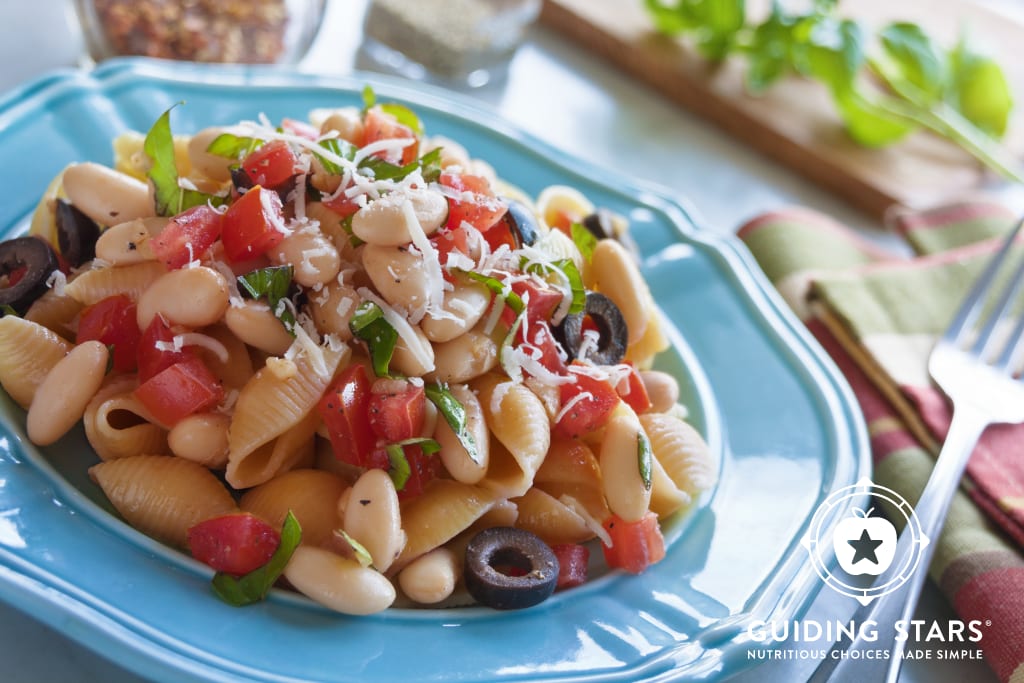Traditional pasta is comfort food for lots of us. Filling, warm, and comforting, regular pasta is generally made from refined semolina flour (from durum wheat, a type grown specifically for pasta). Eggs are sometimes added in, making them egg noodles instead of regular pasta.
White Bean & Olive Pomodoro Pasta
Any recipe that uses pasta can use an alternative pasta for improved nutrition.
View recipe »What’s in traditional pasta?
Nutritionally, traditional pasta provides plenty of carbohydrates but is thin on other nutrients. Why? The refinement of the flour strips away much of the wheat’s fiber, vitamins, and minerals. Enrichment of the flour with iron and a few B vitamins makes up for some of the nutrient losses, but not all of them.
Should you consider switching up your pasta?
If you eat pasta frequently, you might want to think about trying a pasta alternative. Why? There are nutritional differences, depending on which alternative you choose. Mixing it up helps you cover your bases, so to speak. As with variety in anything, eating different types of pasta helps you get a wider range of nutrients into your diet—and likely more fiber as well.
What about whole-wheat pasta?
Whole-wheat pasta certainly isn’t new, and chances are good that you’ve already tried it. Whole-wheat pasta is made from less-refined wheat flour, and therefore contains more fiber and more nutrients than traditional pasta, although the protein content is about the same. Other whole-grain pastas are made from grains like kamut, spelt, brown rice, and amaranth—even quinoa, which is technically a seed but works like a grain in many products. If whole wheat pasta or other whole-grain pastas don’t taste great to you, or you can’t get used to the grainy, chewy texture, feel free to combine it with traditional pasta in a 50-50 mix. There’s no shame there! (Also, check out this great idea for boosting the appeal of whole-wheat pasta.) Just be sure to check cook times—you’ll probably need to start cooking the whole grain variety first, then add the traditional pasta to the pot after a few minutes.
What are the nutritional highlights of alternate pastas?
There is a wide variety of new (and sometimes unusual) pastas available—and they’re not all created equal when it comes to nutrition. Here are the basics…
Bean/legume-based Pasta
Legume pastas tend to be significantly higher in protein than traditional pasta, and have more fiber, too (the amount depends on the legume used). They can be a variety of colors and the tastes range as well. Lentil and chickpea versions might be the least bean-y tasting, but you’ll need to see what your family prefers. Also look for protein-enhanced pasta, which is made from wheat, but has bean or lentil protein added (its color is close to traditional pasta).
Quinoa Pasta
Quinoa pasta tends to be made from a mix of grains, so amaranth, chickpea, or corn is typically added. It tends to be higher in protein than traditional pasta, and may be a bit higher in fiber as well.
Veggie Pasta
While vegetable pastas used to have so little vegetables in them that it did little but add color, the newer varieties do contain more pureed veggies, such as carrots, spinach, and tomato. However, in order to get the “full serving of veggies” that is typically advertised on the packages (one brand boasts 3 servings of veggies!), you’ll need to eat a bigger portion. Lots of folks eat more than the 2 oz. portion of pasta so maybe this won’t be an issue, but keep in mind that bigger portions come with more calories in general—not even counting what you put on top of the pasta.
So if pasta is your pleasure and you eat it often, give a new variety a try for fun and more nutrition. You might just find a new favorite—and at the very least, you can mix it with your old standby. And while you’re at it, give a new pasta recipe or two a try as well.
